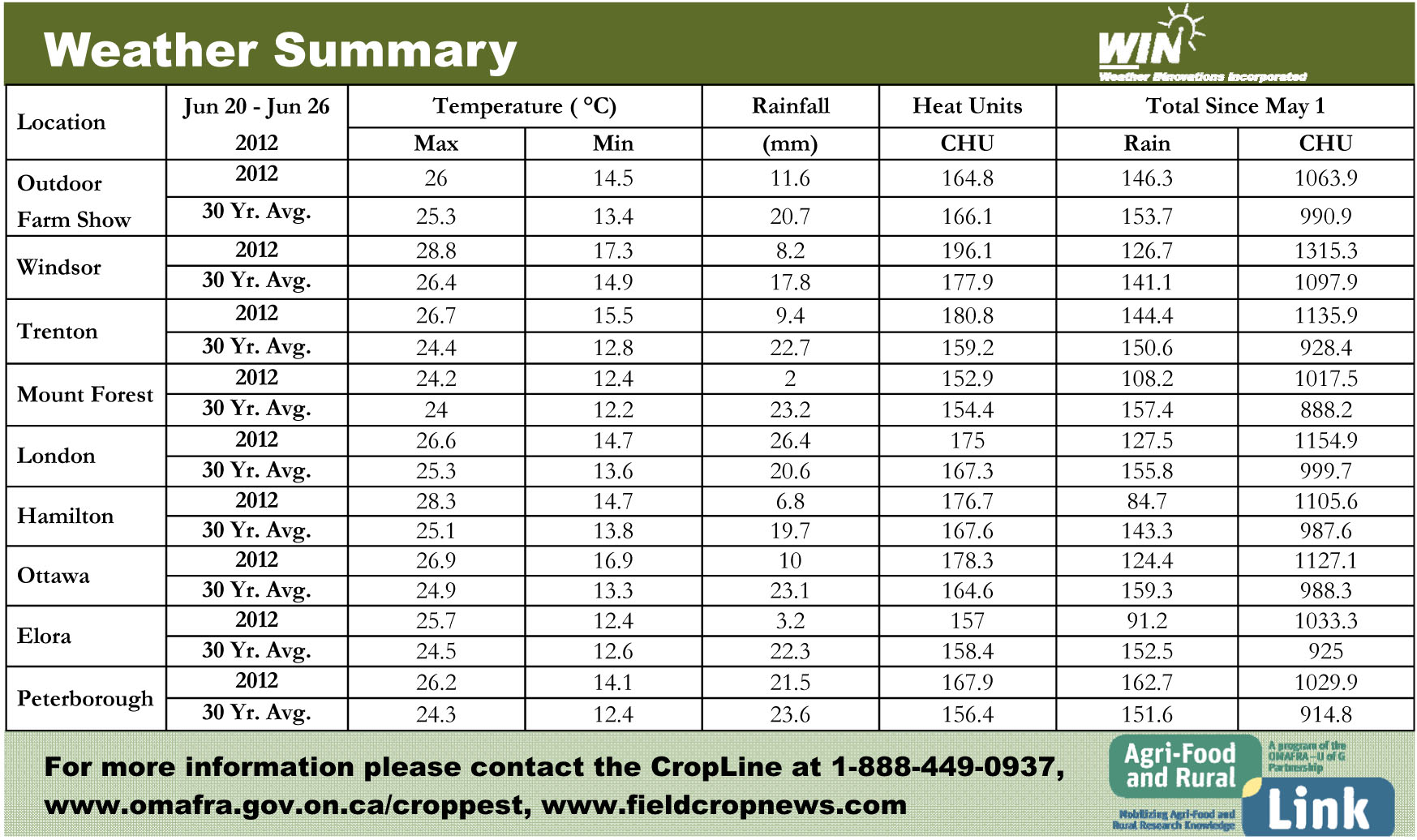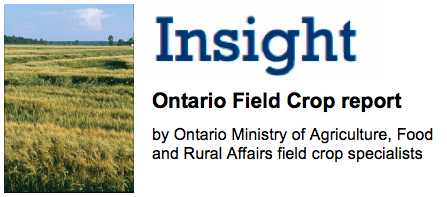Corn: Greg Stewart
Corn is developing rapidly; adding 2-3 leaves in the last week. The crop looks very good in most areas but moisture stress is starting to show in areas receiving little rainfall.
Monitor carefully the fast approaching fungicide application window (tassel emergence to early silk), for early planted corn this may arrive July 8-15 in some areas. Predicting the yield improvement from a fungicide application has not been easy. Dr. Dave Hooker (UG) has conducted many trials over a number of years and observed an average yield gain for a tassel time fungicide application of about 6 bu/acre. Consider the profit potential after covering costs associated with product, application, and a slight increase in drying costs (i.e. corn at 23% moisture instead of 22%).
Hooker’s research suggests that the likelihood of yield improvements greater than 6 bu/ac increases as one or more of the following conditions exist: 1 - high yield potential (large canopy, high populations, high fertility, uniform stand, etc.), 2 - when corn follows corn in rotation, 3 - when there is evidence of some disease on the ear leaves at VT (application timing) or 4 - when the forecast is for average to above average precipitation.
Cereals: Peter Johnson/Scott Banks
Wheat harvest should begin later this week in Essex. High forecast temperatures will shorten grain fill. French research indicates 1 bu/ac/day yield loss for every day temperatures exceed 25°C. Some lodging occurring in areas experiencing high winds and heavy rains: this indicates good yield potential despite short crops. Straw continues to be in high demand. Fusarium levels remain low in the crop, but more symptoms are showing in unsprayed fields than expected. Sprayed fields are showing excellent disease control and much better stay-green than unsprayed fields.
Spring cereals continue their rapid development, with early spring barley as mature as winter wheat. Growers are disappointed with some fields, due to extreme variability from uneven emergence. Leaf diseases remain very low, although rust in wheat and oat fields is ramping up and could significantly impact late planted crops.
Canola/Edible Beans: Brian Hall
Canola: Cabbage seedpod weevil adult populations have diminished and no longer warrant control. Diamond back moths (DBM) are at threshold levels in several canola fields. DBM and tarnished plant bug cause greater yield losses in years of dry weather. DBM larvae are pale green and 12mm long at maturity, initially feeding on leaves causing shot holes but then moving to flower buds and pods where most of the damage occurs. Damage is usually first evident on field ridges and knolls. Scout by removing plants from a 1 foot square area, beating the plants above a white cloth and count the number found on the cloth. Control is warranted if 20-30 larvae (2- 3 larvae per plant) or 10-15 larvae per sq foot are found at pod and flowering stages respectively.
Edible Beans: Majority of edible beans are at 1-3rd trifoliate stage with generally good populations. Leafhoppers (LH) can be found in most fields, although populations are generally below threshold and do not warrant control. Scout fields up to early flower stage for LH and control if populations exceed 1 per trifoliate. If root rot is evident the only remedy is to improve soil aeration through inter-row cultivation and apply nitrogen if none has been applied to stimulate root growth.
Forages & Pastures: Jack Kyle / Joel Bagg
Forages: First-cut hay is finishing while second-cut haylage is complete on some dairy farms. With reduced yields and acres, hay inventories are limited in some areas and record high prices are being reported. There are still reports of armyworm and also European skipper feeding damage to forage grasses (http://fieldcropnews.com/?p=3925). Potato leafhoppers (PLH) have arrived and can dramatically reduce alfalfa yield and forage quality. New seedings are very susceptible and can be permanently damaged. Adults are 3mm” long, lime-green and wedge-shaped. The wedge-shaped “hopperburn” damage is often confused with moisture or heat stress. The damage results in reduced stem elongation, root development and stand vigor leading to stunted and slow regrowth. Once hopperburn is observed, the damage is done and it is too late for control, so scout using recommendations at the following link (http://fieldcropnews.com/?p=3902). Farmers in the high risk areas north of Lake Erie should consider growing PLH resistant alfalfa varieties.
Pastures: Across the province pastures are variable depending on moisture levels, and army worm damage. Assess pastures for potential growth and take the necessary steps to have adequate forage available (applying nitrogen, plant an annual crop, use 2nd growth on hay fields as pasture, etc).
Soybeans: Horst Bohner
Soybean fields are now flowering (R1 growth stage). Moisture stress is becoming evident in dry areas although the majority of the crop is in excellent condition. Low numbers of soybean aphids have been found in isolated fields but numbers remain well below threshold. Nutrient deficiencies are evident in fields with low soil reserves or because root growth is limited. Potassium deficiency results in yellowing around the margins of the leaf. With the high nutrient requirement of potassium, foliar liquid fertilizers do not deliver enough kg/ha of actual product. Broadcast application of dry fertilizer in crop has worked on occasion but is highly dependent on the amount of rainfall after application. The best time to apply potassium is during the fall prior to the soybean crop.




